Supergirl’s most recent episode, “The Martian Chronicles,” teased (and delivered) some big revelations about the titular Martian characters, along with the series’ second episode-length homage to John Carpenter’s The Thing of the season. But, as has been the case with much of the series, the overarching plot details and DC lore minutiae mainly played out as background to ongoing stories involving character relationships – or, in poor lonely Supergirl’s case, a lack thereof.
But the episode’s closing moments were a different story entirely, with a preview for next week’s show teasing the live-action debut of one of the Superman mythos most dangerous relics: Lex Luthor’s Warsuit.
WAIT, LEX LUTHOR’S WHAT?
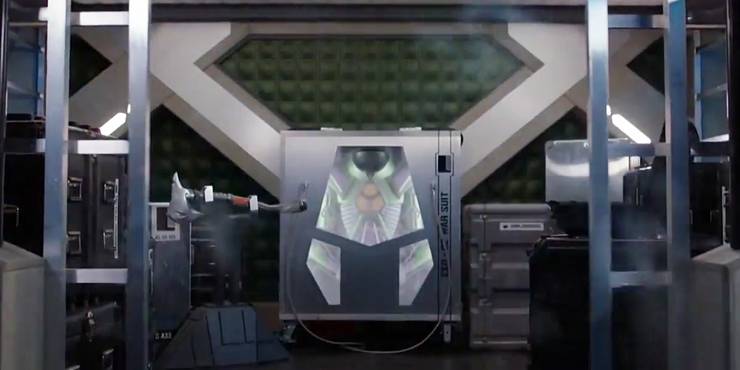
For those not intimately familiar with the deeper cuts of DC comics’ lore, Luthor’s Warsuit is exactly what it sounds like: A suit of powered-armor that allows the criminal mastermind to go toe-to-toe against Superman (or other, similarly-powered individuals) in a physical fight.
Created in 1983, it was only an “official” presence in Superman comics for a few years before being wiped out (along with the majority of prior Superman stories and more “out there” concepts) by the joint retcon-events of Crisis on Infinite Earths and The Man of Steel: the John Byrne-driven reboot of the Superman franchise. But its core concept (“What if Lex Luthor was as strong as Superman!?”) and memorable design (courtesy of comics legend George Perez) made it iconic enough to be “resurrected” several times in the intervening decades. But one place it’s never been seen is in live action… Until now.
What does its presence in the preview (presumably in the hands of Lillian Luthor, her CADMUS lackeys, or even her daughter Lena) mean for the TV version of Kara Zor-El? Probably nothing good. Where did it come from? Well, that’s a little complicated…
LEXOR
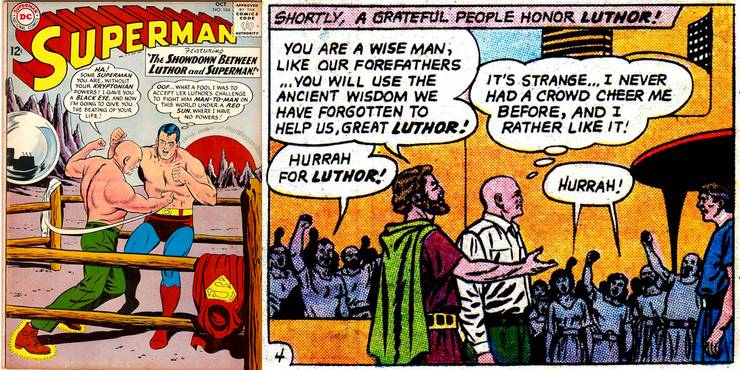
Understanding the origins of Luthor’s Warsuit means understanding Planet Lexor – which in turn means understanding that the conception of Lex Luthor most familiar to present day fans of Superman (i.e. a slick, seemingly-legitimate business tycoon with secret world-domination ambitions and a hate-on for The Man of Steel) has only existed in the comic source material since it was reworked in 1986 for Byrne’s Man of Steel reboot; which (using the universe-wide reboot events of The Crisis) aimed to streamline the Superman mythos by removing characters like Supergirl, the Super-Pets, Lex Luthor’s extended family and their shared backgrounds as Smallville teenagers in the (now non-canonical) pages of Superboy.
Pre-Crisis, Luthor was a super-genius mastermind of seemingly all scientific and mechanical fields who sought to alternately conquer the world and destroy Superman. Originating with the Man of Steel himself in the 1930s, by the time the 60s rolled around and comics fans began seeking more coherent motivations from their villains, Lex and Superman had been fighting for so long it was almost beside the point to give him one (for the record: Teenage Lex blamed Superboy for the chemical accident that left him permanently bald. Yeah, that was really it.)
Throughout the Silver Age of comics (roughly the 60s to the early 80s, depending on how you count) Superman and Luthor engaged in increasingly more outlandish battles to keep things fresh, and one such battle took place in 1963’s Superman #164: “The Showdown Between Luthor and Superman!” Luthor gets Kal-El to agree to a “final battle” in the form of a boxing match on a planet whose red sun will render them equally matched. But while fighting, the two are separated by a sandstorm that leaves Luthor wandering into the care of a community of the planet’s struggling, stone age humanoid inhabitants.
Initially acting out of self-interest, Luthor introduces the aliens to rudimentary (but “miraculous” to them) science and technology, and shows them how to reactivate the long-dormant machinery of their forgotten ancestors’ own lost civilization. But while Lex is gradually acclimating to the experience of being a “hero” to people, he can’t solve their core problem: Their planet is out of water. So when Superman finally shows up to collect his arch-nemesis, he’s surprised to instead confront a community that reveres Lex Luthor as their equivalent of a Superman (a stranger visitor from another planet with miraculous gifts). Ultimately, Lex strikes a deal: He’ll return to Earth and answer for his crimes there… if Superman will use his powers to re-introduce water to the planet’s ecosystem. Subsequently, the natives rename their world “Lexor” and honor their (now-absent) savior Lex Luthor as a god-king.
LUTHOR UNLEASHED
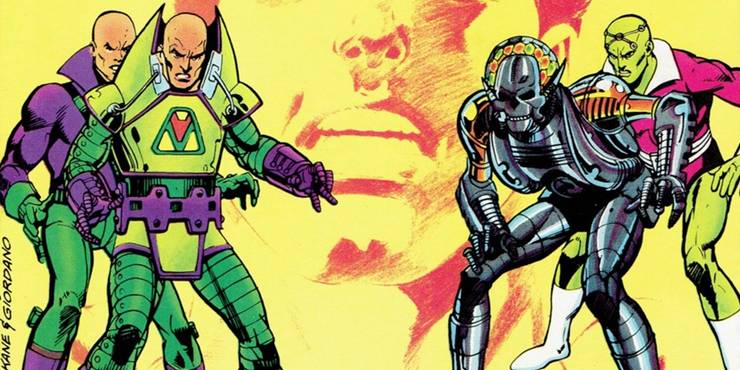
Planet Lexor would continue to appear as a plot element of the Superman cosmology throughout the Silver Age, serving as a favorite hideout/getaway for Luthor (who never bothers to tell the inhabitants the truth about who he and Superman really are to one another, or his own supervillain status on Earth) and a convenient point of origin for his increasingly extreme anti-Superman weaponry. He even found time to take a Lexoran woman, Ardora, for a wife and to father a son named Lex Jr. And if you’re thinking this status quo sounds a bit too tenuous to last, well… you would be correct.
In the landmark 1983 storyline “Luthor Unleashed” (Action Comics #545, which also introduced a new fully robotic-looking version of Brainiac), Lex decides he’s finally taken his last shot at killing Superman and opts to retire to Lexor permanently; confessing the truth of his life to Ardora and vowing to dedicate himself to being a just guardian of the one planet that doesn’t hate him – good thing, too, as it turns out technological safeguards installed by Luthor are the only thing keeping Lexor from exploding Krypton-style (yup, this is going where you think it is.)
Sadly, Lex is unable to help himself once he discovers that ancient Lexoran battle-armor tech, slightly-modified, will give him the strength to match Superman. So he builds The Warsuit, which was actually somewhat divisive among fans at the time. Many objected to it as a betrayal of the classic Luthor/Superman “brains-vs-brawn” dynamic, and others were annoyed that it had been willed into existence mainly to make Luthor more “toyetic” for the then-popular DC Super Powers action figure line.
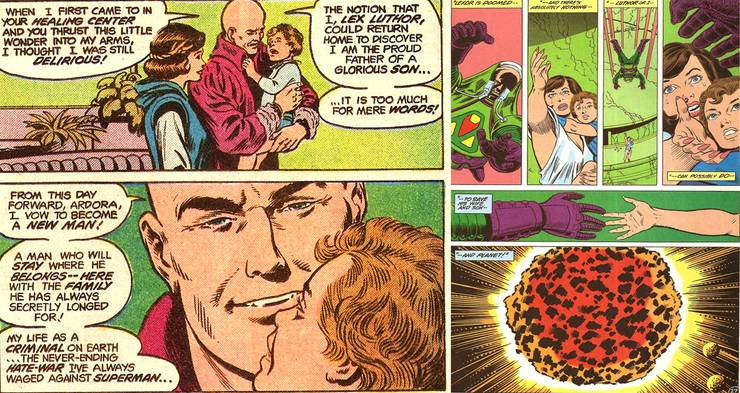
Eventually, events conspire to bring Superman back to Lexor to collect Luthor once again. Rather than explain that he’s actually (sort of) innocent of the series of incidents in Metropolis that brought his old foe there in the first place, Luthor attacks Superman using the fully-armed Warsuit for what he hopes will be the Final Battle for real this time. During the fight, a blasts from Luthor accidentally damages the machinery keeping the planet stable, and Lexor – along with Ardora, Lex Jr. and all of the other inhabitants – are vaporized, leaving Lex and Superman the only survivors. Lex is driven into full-blown madness, vowing henceforth to use his Warsuit to not only defeat the Man of Steel but personally crush him hand-to-hand.
But he’d never get that chance: Just a few years later, Crisis on Infinite Earths led Luthor (armor and all) to join his fellow villains in aligning with the DC superheroes to prevent the end of the universe – with the resulting cosmic cataclysm resetting reality into a state where the majority of their pre-1980s entanglements (including everything involving Lexor) had never happened. And while a great deal of the “Pre-Crisis” Superman ephemera would gradually filter back into official continuity, The Warsuit never fully did… for almost 20 years.
WORLD’S FINEST
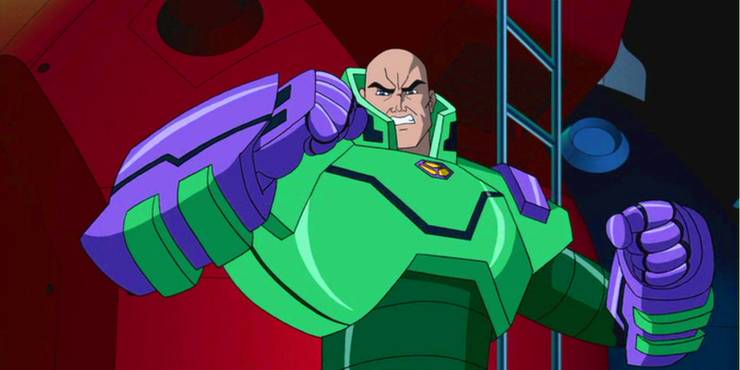
In 2003, as part of the inaugural storyline (alternately known as “World’s Finest” and “Public Enemies”) of the Batman/Superman comic series, Lex Luthor (Post-Crisis model) gets himself elected President of The United States and effectively declares Superman illegal. The ensuing storyline, which features Superman and Batman battling all-star teams of both classic villains and their former friends, reaches it’s climax with Luthor busting out a trump-card that took longtime DC fans collective breath away: The Silver-Age Warsuit!
…or, at least, something that looked just like it.
Ultimately, the “new” Warsuit is revealed to be a fresh creation of Luthor’s, powered-up by a mix of Apokolips’ technology, Kryptonite and Bane’s Venom serum. But even all that isn’t quite enough to stop the combined might of DC’s two biggest heroes. President Luthor loses in his new Warsuit’s debut; but having already raised fan antennas with the revival of one of the all-time “lost” relics of the Pre-Crisis Silver Age, he makes his exit (from the story) with a chilling proclamation calculated to kick the publisher’s nostalgia-driven early-2000s initiative into overdrive: “There will be a reckoning… A Crisis.”
Two years later, that decidedly-unsubtle hint paid off in the form of “Infinite Crisis,” a 2005-2006 storyline that saw tangent strands of Pre-Crisis continuity (and, ultimately, the entire Multiverse itself) crashing back into the reality of the DC Universe. As one long-term side-effect of this, while Luthor remains primarily his “businessman gone bad” self from the immediate Post-Crisis era, elements of his more extreme megalomaniac mad-scientist era have crept back into his characterization – including the continued off and on use of Warsuits.
REBIRTH
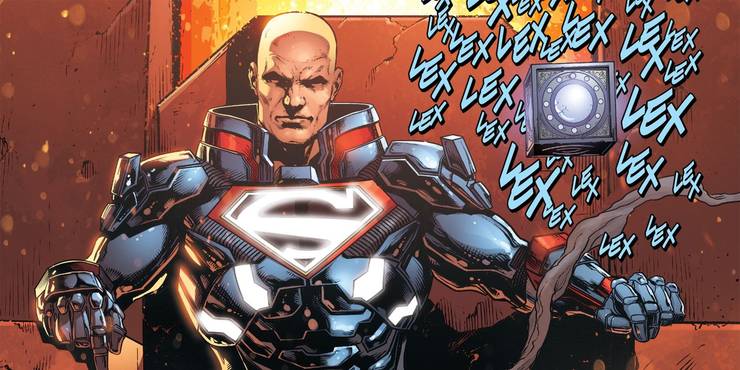
DC has retooled the wholesale continuity of its universe multiple times since Infinite Crisis, and a notable part of that constant shakeup has been constant revamping of Lex Luthor’s villain status – and a whole slew of new variations on the Warsuit concept – he even wore an (appropriately recolored) version of it during his brief stint as wielder of an Orange Lantern ring.
Most recently, Luthor even donned a Superman-inspired verion of a Warsuit (created at his behest from a Mother Box) in order to christen himself the new savior of Metropolis following what had appeared to be the actual Superman’s most recent death in battle. Wherever Luthor goes next, one thing seems to be for certain: The Warsuit will never be fan behind.
But what does it mean for the infamous armor to turn up in the world of Supergirl? That’s somewhat more difficult to pin down…
IT RUNS IN THE FAMILY?

We don’t yet know whose Warsuit that actually is – or anything else about it, other than that it appears to be housed (at least for now) in some kind of secure facility (possibly at The DEO?) that also includes the Kryptonian-cutting battle axe wielded by the first alien criminal Kara busted in Season 1. Is it alien? Man-made? A bit of both? Does it already belong to one of the Luthors?
In Supergirl’s continuity, Lex Luthor is positioned as (thus far) unseen, having been imprisoned in a secure facility after being thwarted by Superman in the midst of a large-scale crime similar to his cinematic counterpart’s ploy to destroy California in the 1978 Superman: The Movie several years before the beginning of the series. Beyond that, little has been confirmed about his other evil plots – meaning that it’s conceivable for Supergirl to reveal the Warsuit as something he previously deployed against his arch-nemesis (that Martian Manhunter J’onn J’onzz initially kept several anti-Kryptonian weapons at DEO Headquarters “just in case” was a key plot detail in season 2’s debut episodes.)
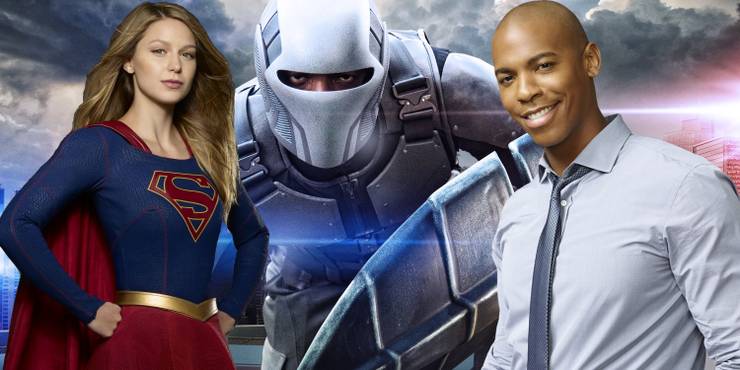
But if where it comes from is hard to determine, how it will be used is anybody’s guess – period. Supergirl has two Luthors in her life in Lena and Lillian, and given the female-forward bent of the series it feels well within the realm of possibility that one of them might wind up in the suit… but why? Lillian Luthor is a straightforward villain, but Lena has remained in a state of will-she-or-won’t-she moral unknowableness (Schroedinger’s Supervillain?) thus far: She could well put on the armor to embrace her perceived evil destiny, but she could just as easily end up using it for heroic ends; living up to her stated aim of reforming her family name by any means necessary.
Another potential candidate? James Olsen – who’s spent season 2 working through a bad case of superpower-envy as The Guardian in the wake of Kara rebuffing his romantic intentions (seemingly) in favor of the similarly-superhuman Mon-El and is already chaffing at the edges of what his current suit of armor allows him to do. In terms of unexpected usage of DC Comics iconography, the onetime “Jimmy” Olsen using Lex Luthor’s Warsuit would be fairly high up on the list. But the only way to know for sure, ultimately, will be tuning in to Supergirl to see what happens… and to who.



